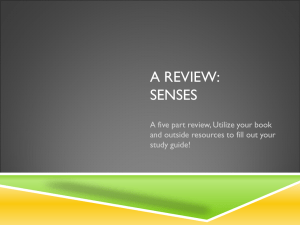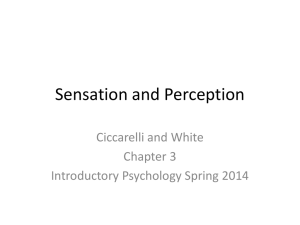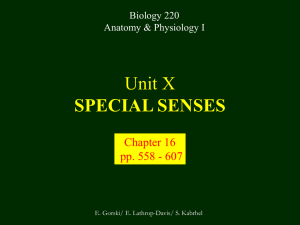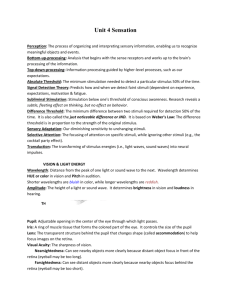Nervous System Lecture
advertisement
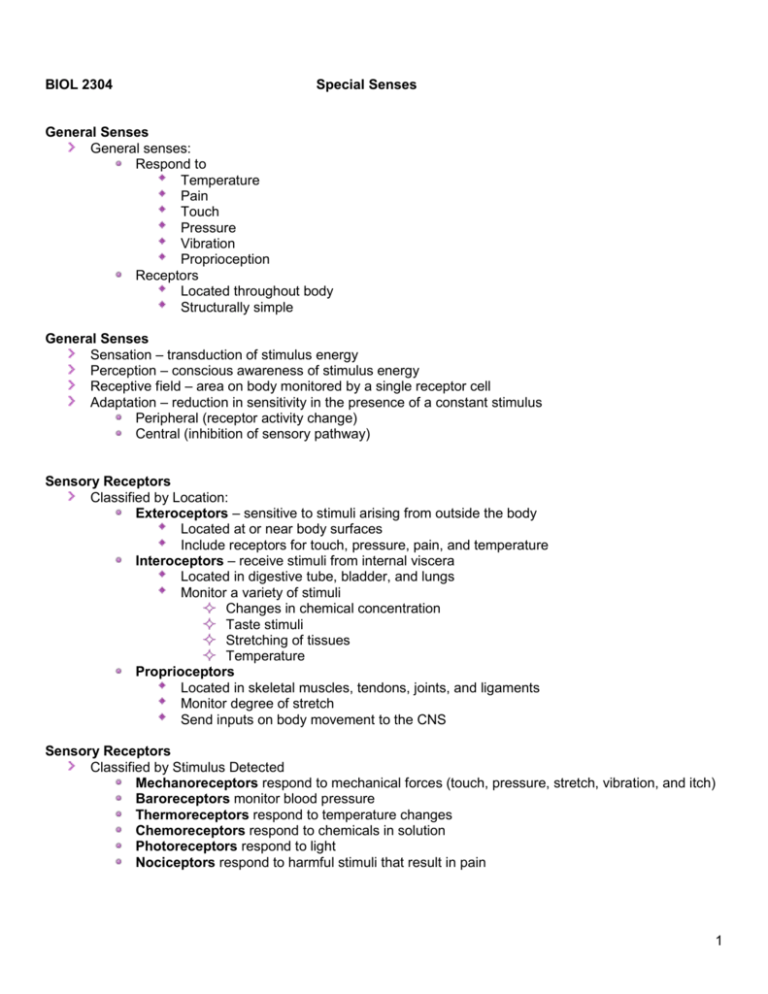
BIOL 2304 Special Senses General Senses General senses: Respond to Temperature Pain Touch Pressure Vibration Proprioception Receptors Located throughout body Structurally simple General Senses Sensation – transduction of stimulus energy Perception – conscious awareness of stimulus energy Receptive field – area on body monitored by a single receptor cell Adaptation – reduction in sensitivity in the presence of a constant stimulus Peripheral (receptor activity change) Central (inhibition of sensory pathway) Sensory Receptors Classified by Location: Exteroceptors – sensitive to stimuli arising from outside the body Located at or near body surfaces Include receptors for touch, pressure, pain, and temperature Interoceptors – receive stimuli from internal viscera Located in digestive tube, bladder, and lungs Monitor a variety of stimuli Changes in chemical concentration Taste stimuli Stretching of tissues Temperature Proprioceptors Located in skeletal muscles, tendons, joints, and ligaments Monitor degree of stretch Send inputs on body movement to the CNS Sensory Receptors Classified by Stimulus Detected Mechanoreceptors respond to mechanical forces (touch, pressure, stretch, vibration, and itch) Baroreceptors monitor blood pressure Thermoreceptors respond to temperature changes Chemoreceptors respond to chemicals in solution Photoreceptors respond to light Nociceptors respond to harmful stimuli that result in pain 1 Sensory Receptors Classified by Structure Free Nerve Endings – naked dendrites Merkel’s – stratum basale (basal layer) of epidermis, light touch Hair follicle receptors – reticular layer of dermis Encapsulated Nerve Endings – dendrites enclosed by connective tissue Meissner’s – dermal papilla (papillary layer of dermis), discriminative touch Pacinian – hypodermis, deep touch Ruffini – dermis and hypodermis, deep touch Proprioceptors – in muscles/tendons, monitor stretch Major Somatosensory Pathaways Spinothalamic Pathways Anterior spinothalamic tract carries crude touch and pressure sensations. Crude touch to right side of body activates receptor that synapses in spinal cord 2nd neuron decussates anteriorly and ascends medially to thalamus, where it synapses. Thalamic neuron ascends to primary somatosensory cortex (post-central gyrus) where it synapses, and perception occurs. Lateral spinothalamic tract carries pain and temperature sensations. Painful stimulus to right side of body activates receptor that synapses in spinal cord. 2nd neuron decussates anteriorly and ascends laterally to thalamus, where it synapses. Thalamic neuron ascends to primary somatosensory cortex (post-central gyrus) where it synapses, and perception occurs. Posterior Column Pathway Posterior column tract carries fine touch sensations. Fine touch to right side of body activates receptor that ascends dorsally and synapses ipsilaterally in the medulla. 2nd neuron decussates and ascends medially to thalamus, where it synapses. Thalamic neuron ascends to primary somatosensory cortex (post-central gyrus) where it synapses, and perception occurs. Spinocerebellar Pathway Spinocerebellar tract carries proprioceptive sensations. Proprioceptive sensations from the right and left sides of the body activate receptors that synapse in the spinal cord. One of the 2nd order neurons decussates and ascends to the cerebellum. The other 2nd order neuron ascends ipsilaterally to the cerebellum. 2 Sensory Homunculus Each region of the sensory cortex corresponds to a body regions. The amount of cortical space dedicated to that body region is proportional to the number of sensory receptors located in that body region. This is the sensory homunculus Motor Homunculus Corticospinal pathway provides voluntary control over skeletal muscles. Neurons in primary motor cortex (pre-central gyrus) descend, decussate in the medulla and synapse onto anterior spinal cord neurons. The 2nd order neuron is a motor neuron that synapses onto a skeletal muscle There is a corresponding motor homunculus Sensory and Motor Maps Mapping is plastic Changes with experiences Changes with use/disuse Changes with injury 3 Olfactory Anatomy Olfactory receptors are part of the olfactory epithelium Olfactory epithelium is pseudostratified columnar and contains three main cell types: Olfactory sensory neurons Supporting epithelial cells Basal epithelial cells Cell bodies of olfactory sensory neurons Located in olfactory epithelium Have an apical dendrite that projects to the epithelial surface Ends in a knob from which olfactory cilia radiate Olfactory cilia act as receptive structures for smell Mucus captures and dissolves odor molecules Pathway for Olfactory Perception Axons of olfactory epithelium Gather into bundles—filaments of the olfactory nerve Pass through the cribriform plate of the ethmoid bone Attach to the olfactory bulbs and synapse with mitral cells Mitral cells transmit impulses along the olfactory tract to Limbic system Piriform lobe of the cerebral cortex 4 Anatomy of Gustation Taste receptors Occur in taste buds Most are found on the surface of the tongue Located within tongue papillae Two types of papillae (with taste buds) Fungiform papillae Vallate papillae Anatomy of Gustation Collection of 50 –100 epithelial cells Contain two major cell types Gustatory epithelial cells supporting cells Basal epithelial cells gustatory cells Contain long microvilli – extend through a taste pore to the surface of the epithelium Cells in taste buds replaced every 7–10 days Anatomy of Gustation Pathway for Perception of Taste Taste information reaches the cerebral cortex Primarily through the facial (VII) and glossopharyngeal (IX) nerves Some taste information through the vagus nerve (X) Sensory neurons synapse in the medulla Located in the solitary nucleus Impulses are transmitted to the thalamus and ultimately to the gustatory area of the cerebral cortex in the insular lobe 5 Pathway for Perception of Taste Accessory Structures of the Eye Eyebrows – coarse hairs on the superciliary arches Eyelids (palpebrae) – separated by the palpebral fissure Meet at the medial and lateral angles (medial & lateral canthi) Lacrimal caruncle – reddish elevation at the medial canthus Tarsal plates – connective tissue within the eyelids Tarsal glands – modified sebaceous glands Conjunctiva – transparent mucous membrane Palpebral conjunctiva Bulbar conjunctiva Conjunctival sac 6 Accessory Structures of the Eye Lacrimal apparatus – keeps the surface of the eye moist Lacrimal gland – produces lacrimal fluid Lacrimal sac – fluid empties into nasal cavity Lacrimal puncta (punctum) – minute opening of the nasolacrimal duct on the margin of each eyelid near the medial commissure; drains tears from the eye, through the nasolacrimal duct and into nasal cavity Extrinsic Eye Muscles Six muscles that control movement of the eye Originate in the walls of the orbit Insert on outer surface of the eyeball Annular ring – origin of the four rectus muscles The six extrinsic eye muscles are: Lateral rectus and medial rectus Superior rectus and inferior rectus Superior oblique and inferior oblique Extrinsic Eye Muscles 7 Anatomy of the Eyeball The Fibrous Layer – most external layer of the eyeball Composed of two regions of connective tissue Sclera – posterior five-sixths of the tunic White, opaque region Provides shape and an anchor for eye muscles Cornea – anterior one-sixth of the fibrous tunic Limbus – junction between sclera and cornea Scleral venous sinus – allows aqueous humor to drain The Vascular tunic (layer) – the middle coat of the eyeball Composed of choroid, ciliary body, and iris Choroid – vascular, darkly pigmented membrane Forms posterior five-sixths of the vascular tunic Brown color – from melanocytes Prevents scattering of light rays within the eye Choroid corresponds to the arachnoid and pia maters Ciliary body – thickened ring of tissue, which encircles the lens Composed of ciliary muscle Ciliary processes – posterior surface of the ciliary body Ciliary zonule (suspensory ligament) - attached around entire circumference of the lens Iris Visible colored part of the eye Attached to the ciliary body Composed of smooth muscle Pupil – the round, central opening Sphincter pupillae muscle Dilator pupillae muscle – act to vary the size of the pupil Anatomy of the Eyeball 8 Anatomy of the Eyeball The retina – the deepest tunic, the inner layer (sensory tunic) Composed of two layers Pigmented layer – single layer of melanocytes Neural layer – sheet of nervous tissue Contains three main types of neurons Photoreceptor cells (rods & cones) Bipolar cells Ganglion cells Microscopic Anatomy of the Retina Humors of the Eye Posterior segment (cavity) Filled with vitreous humor Clear, jelly-like substance Transmits light Supports the posterior surface of the lens Helps maintain intraocular pressure Anterior segment Divided into anterior and posterior chambers Anterior chamber – between the cornea and iris Posterior chamber – between the iris and lens Filled with aqueous humor Renewed continuously Formed as a blood filtrate Supplies nutrients to the lens and cornea 9 Humors of the Eye Pathway for the Perception of Light Pathway begins at the retina. Light activates photoreceptors Photoreceptors signal bipolar cells Bipolar cells signal ganglion cells Axons of ganglion cells exit eye as the CN II (optic nerve) Optic nerve signals lateral geniculate nucleus of the thalamus Thalamus signals primary visual cortex 10 Anatomy of the Ear The ear – receptor organ for hearing and equilibrium Composed of three main regions: Outer ear – functions in hearing Middle ear – functions in hearing Internal ear – functions in both hearing and equilibrium Anatomy of the Outer Ear The auricle (pinna) Helps direct sounds External acoustic meatus Lined with skin Contains hairs, sebaceous glands, and ceruminous glands Tympanic membrane Forms the boundary between the external and middle ear Anatomy of the Ear Anatomy of the Middle Ear Composed of The tympanic cavity A small, air-filled space Located within the petrous portion of the temporal bone Medial wall is penetrated by Oval window Round window Pharyngotympanic tube (auditory or eustachian tube) Links the middle ear and pharynx 11 Anatomy of the Middle Ear Ear ossicles – smallest bones in the body Malleus – attaches to the eardrum Incus – between the malleus and stapes Stapes – vibrates against the oval window Anatomy of the Middle Ear Anatomy of the Inner Ear Membranous labyrinth Series of membrane-walled sacs and ducts Fit within the bony labyrinth Consists of three main parts Organs of equilibrium Semicircular ducts Utricle and saccule Organ of hearing Cochlear duct 12 Anatomy of the Inner Ear Anatomy of the Inner Ear Hair cells in the cochlea Inner hair cells are the receptors that transmit vibrations of the basilar membrane Outer hair cells actively tune the cochlea and amplify the signal Pathway for Perception of Sound Vibrations of basilar membrane signal hair cells Hair cells signal Cranial nerve VIII (vestibulocochlear nerve) Cranial nerve VIII signals a nucleus (superior olivary) in the medulla/pons SO nucleus signals the inferior colliculus Inferior colliculus signals medial geniculate nucleus of thalamus Thalamus signals primary auditory cortex (temporal lobe) 13 Pathway for Perception of Sound Anatomy of Equilibrium Utricle and saccule – suspended in perilymph Two egg-shaped parts of the membranous labyrinth House the macula – a spot of sensory epithelium Macula – contains receptor cells Monitor the position of the head when the head is still Contains columnar supporting cells Hair cells synapse onto vestibular nerve. Anatomy of Equilibrium Semicircular duct – snakes through each semicircular canal Membranous ampulla – located within bony ampulla Houses a structure called a crista ampullaris Cristae contain receptor cells of rotational acceleration Epithelium contains supporting cells and receptor hair cells 14 Pathway for Equilibrium Vibrations of semicircular ducts, utricle, and saccule signal hair cells Hair cells signal Cranial nerve VIII (vestibulocochlear nerve) Cranial nerve VIII signals the vestibular nuclear complex of the pons The pons signals the cerebellum 15
